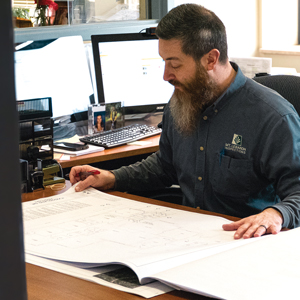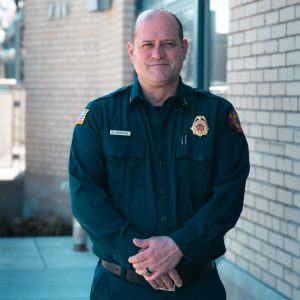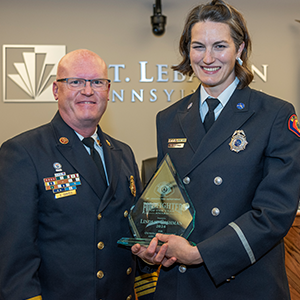fire department re-ups accreditation

How long does it take you to get out the door in the morning? At the Mt. Lebanon Fire Department, they’re gone in 80 seconds, 96 percent of the time. That stat is just one of the 1,053 pieces of information the department collected to submit as part of its application to be an accredited agency from the Commission on Fire Accreditation International. The department is expected to receive that re-accreditation on Tuesday, March 21, when the four fire chiefs who visited the department this fall recommend the honor to the commission at a meeting in Orange County, California.
If the department is re-accredited as expected, it will be one of about 200 accredited agencies in the country.
Mt. Lebanon first received accreditation in 2012, and although it has filed annual reports and updated its strategic plan, it is required to redo the entire process every five years to keep the status. The cost is $1,190 each year to maintain the paperwork during the term.
“I’m proud to say this department has been validated against best practices and national standards,” says Fire Chief Nick Sohyda. On the other hand, he says, “We can’t sit and rest on it for five years. We’re always looking for the next great challenge.”
The self-review process is heavily data-driven—it examines 257 performance indicators to evaluate how the department is doing its job. And it’s not just the firefighters who are examined. The accreditation process takes into account functions of human resources, finances, legal work and management best practices.
MTLFD continued It looks at how the department operates and seeks ways to make it better over time. “It’s a continuous improvement model,” Sohyda says. “I don’t want the organization to be stagnant, ever. I always want to improve.”

But going for re-accreditation didn’t mean Sohyda could just take 2012’s paperwork and plug in the new data. The commission is always updating the criteria, something Sohyda says is valuable. “Not only are we trying to improve. They’re trying to improve the model.”
When department members look at the data, they examine every area under their control to determine how to improve. For example, they know a key to handling a call quickly is having a lightning-fast turnout time. But it doesn’t end there. How can you really speed up travel time when you can’t drive any faster than you are, and traffic is out of your control? The department worked to get 95 percent of the municipality’s traffic signals outfitted with preemption devices to give fire trucks green lights as they approach.
As part of the process, the firefighters fill out forms for each program the department offers, noting goals, objectives and outcomes and using that information to evaluate performance. Those programs include: medical calls, fire suppression, fire prevention, fire investigation, hazardous materials calls, public education, technical rescue, training, wellness/fitness, communications and community outreach.
Once all the self-examination paperwork is completed, the commission sends four fire chiefs from across the country to visit the department for six days to “validate that we do what we say we’re doing,” Sohyda says. A written report follows. For this evaluation, Sohyda says the department received nine suggestions, none of which were critical, and three of which were clerical errors on his part.
One example of a valuable suggestion was to change the way firefighters treat their gear. Since firefighters are up to three times as likely to get cancer as other people, it’s important for them to decontaminate their gear from the pollutants they encounter. It’s not unusual for a firefighter to throw dirty turnout gear into a car after a fire, but that can cause the dangerous chemicals to release into the car. New procedures call for the gear to be placed in garbage bags and for firefighters to shower immediately after returning from incidents. The gear is washed and the cabs of the fire trucks are hosed down right away.
That’s just one set of steps the department of 17 full-time career firefighters and 47 volunteers is taking to improve.
“I want [residents] to be confident that we are doing a really good job for them, administratively, legally, ethically, morally, financially,” Sohyda says. “We want to make sure they’re getting the service they pay for.”





